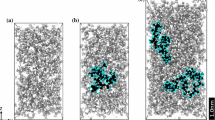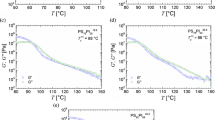Abstract
The effect of linear styrene–butadiene polymer structure on the temperature–viscosity behavior of model polymer-base oil solutions is investigated using molecular dynamics simulations. Simulations of alternating, random, and block styrene–butadiene polymers in a dodecane solvent are used to calculate viscosity at 40 and 100 °C, reference temperatures for characterizing their function as viscosity modifiers. Mechanisms underlying this function are explored by quantifying the radius of gyration and intramolecular interactions of the polymers at the same reference temperatures. The block styrene–butadiene configuration exhibits the least change in viscosity with temperature, characteristic of a good viscosity modifier or viscosity index improver, and the behavior is correlated to the ability of this structure to form smaller coils with more intramolecular interactions at lower temperatures and then expand as temperature is increased. The results indicate that there is a correlation between styrene–butadiene polymer structure, additive function, and the mechanisms underlying that function.




Similar content being viewed by others
References
Bair, S., Qureshi, F.: The high pressure rheology of polymer-oil solutions. Tribol. Int. 36(8), 637–645 (2003)
Simmons, G., Glavatskih, S.: Synthetic lubricants in hydrodynamic journal bearings: experimental results. Tribol. Lett. 42(1), 109–115 (2011)
Jukic, A., Vidovic, E., Janovic, Z.: Alkyl methacrylate and styrene terpolymers as lubricating oil viscosity index improvers. Chem. Tech. Fuels Oils 43(5), 386–394 (2007)
Mohamad, S.A., Ahmed, N.S., Hassanein, S.M., Rashad, A.M.: Investigation of polyacrylates copolymers as lube oil viscosity index improvers. J. Petrol. Sci. Eng. 100, 173–177 (2012)
Jerbić, I.Š., Vuković, J.P., Jukić, A.: Production and application properties of dispersive viscosity index improvers. Ind. Eng. Chem. Res. 51(37), 11914–11923 (2012)
Stöhr, T., Eisenberg, B., Müller, M.: A new generation of high performance viscosity modifiers based on comb polymers. SAE Int. J. Fuels Lubr. 1(2008-01-2462), 1511–1516 (2008)
Morgan, S., Ye, Z., Subramanian, R., Zhu, S.: Higher-molecular-weight hyperbranched polyethylenes containing crosslinking structures as lubricant viscosity-index improvers. Polym. Eng. Sci. 50(5), 911–918 (2010)
Wang, J., Ye, Z., Zhu, S.: Topology-engineered hyperbranched high-molecular-weight polyethylenes as lubricant viscosity-index improvers of high shear stability. Ind. Eng. Chem. Res. 46(4), 1174–1178 (2007)
Ghosh, P., Das, M.: Synthesis, characterization, and performance evaluation of some multifunctional lube oil additives. J. Chem. Eng. Data 58(3), 510–516 (2013)
Fan, J., Müller, M., Stöhr, T., Spikes, H.A.: Reduction of friction by functionalised viscosity index improvers. Tribol. Lett. 28(3), 287–298 (2007)
Spikes, H.: Friction modifier additives. Tribol. Lett. 60(5), 1–26 (2015)
Nunez, C.M., Chiou, B., Andrady, A.L., Khan, S.A.: Solution rheology of hyperbranched polyesters and their blends with linear polymers. Macromolecules 33(5), 1720–1726 (2000)
Ishizu, K., Tsubaki, K., Mori, A., Uchida, S.: Architecture of nanostructured polymers. Prog. Polym. Sci. 28(1), 27–54 (2003)
Knothe, G., Steidley, K.R.: Kinematic viscosity of biodiesel fuel components and related compounds. Influence of compound structure and comparison to petrodiesel fuel components. Fuel 84(9), 1059–1065 (2005)
Gaciño, F.M., Regueira, T., Lugo, L., Comuñas, M.J.P., Fernández, J.: Influence of molecular structure on densities and viscosities of several ionic liquids. J. Chem. Eng. Data 56(12), 4984–4999 (2011)
Kioupis, L.I., Maginn, E.J.: Molecular simulation of poly\(-\alpha -\)olefin synthetic lubricants: impact of molecular architecture on performance properties. J. Chem. Eng. Data 103(49), 10781–10790 (1999)
Bhattacharya, P., Ramasamy, U.S., Krueger, S., Robinson, J.W., Tarasevich, B.J., Martini, A., Cosimbescu, L.: Trends in thermoresponsive behavior of lipophilic polymers. Ind. Eng. Chem. Res. 55(51), 12983–12990 (2016)
Khabaz, F., Khare, R.: Effect of chain architecture on the size, shape, and intrinsic viscosity of chains in polymer solutions: a molecular simulation study. J. Chem. Phys. 141(21), 214904 (2014)
Covitch, M.J., Trickett, K.J.: How polymers behave as viscosity index improvers in lubricating oils. Adv. Chem. Eng. Sci. 5(02), 134–151 (2015)
Selby, T.W.: The non-Newtonian characteristics of lubricating oils. ASLE Trans. 1(1), 68–81 (1958)
Mary, C., Phillipon, D., Lafarge, L., Laurent, D., Rondelez, F., Bair, S., Vergne, P.: New insight into the relationship between molecular effects and the rheological behavior of polymer-thickened lubricants under high pressure. Tribol. Lett. 52(3), 357–369 (2013)
Müller, H.G.: Mechanism of action of viscosity index improvers. Tribol. Int. 11(3), 189–192 (1978)
LaRiviere, D., Asfour, A.F.A., Hage, A., Gao, J.Z.: Viscometric properties of viscosity index improvers in lubricant base oil over a wide temperature range. Part I: group II base oil. Lubr. Sci. 12(2), 133–143 (2000)
Ramasamy, U.S., Lichter, S., Martini, A.: Effect of molecular-scale features on the polymer coil size of model viscosity index improvers. Tribol. Lett. 62(23), 1–7 (2016)
Plimpton, S.: Fast parallel algorithms for short-range molecular dynamics. J. Comp. Phys. 117(1), 1–19 (1995)
Jorgensen, W., Maxwell, D., Tirado-Rives, J.: Development and testing of the opls all-atom force field on conformational energetics and properties of organic liquids. J. Am. Chem. Soc. 118(45), 11225–11236 (1996)
Nosé, S.: A unified formulation of the constant temperature molecular dynamics. J. Comp. Phys. 81(1), 511–519 (1984)
Nosé, S.: A molecular-dynamics method for simulations in the canonical ensemble. Mol. Phys. 52(2), 255–268 (1984)
Hoover, W.G.: Canonical dynamics: equilibrium phase-space distributions. Phys. Rev. A 31(3), 1695–1697 (1985)
Ye, X., Cui, S., de Almeida, V.F., Khomami, B.: Effect of varying the 1–4 intramolecular scaling factor in atomistic simulations of long-chain n-alkanes with the opls-aa model. J. Mol. Model 19(3), 1251–1258 (2013)
Müller-Plathe, F.: Reversing the perturbation in non-equilibrium molecular dynamics: an easy way to calculate the shear viscosity of fluids. Phys. Rev. E 59(5), 4894–4898 (1999)
Kelkar, M.S., Rafferty, J.L., Maginn, E.J., Siepmann, J.I.: Prediction of viscosities and vapor-liquid equilibria for five polyhydric alcohols by molecular simulation. Fluid Phase Equilib. 260(2), 218–231 (2007)
Tenney, C.M., Maginn, E.J.: Limitations and recommendations for the calculation of shear viscosity using reverse nonequilibrium molecular dynamics. J. Chem. Phys. 132(1), 014103 (2010)
Jacobs, T.B.D., Martini, A.: Measuring and understanding contact area at the nanoscale: a review. Appl. Mech. Rev (2017)
Lemmon, E.W., McLinden, M.O. , Friend, D.G.: Thermophysical properties of fluid systems. In: Linstrom, P.J., Mallard, W.G. (eds.). NIST Chemistry WebBook, NIST Standard Reference Database Number 69. National Institute of Standards and Technology, Gaithersburg MD (retrieved August 17, 2017)
Zakarian, J.: The limitations of the viscosity index and proposals for other methods to rate viscosity-temperature behavior of lubricating oils. SAE Int. J. Fuels Lubr. 5(2012-01-1671), 1123–1131 (2012)
Zempel, R.W.: Poly(Styrene-Butadiene). In: Tracton, A.A. (ed.) Coatings Technology Handbook, 3rd edn. CRC Press, Boca Raton (2005)
Acknowledgements
We thank David Gray, Joan Souchik and Ewa Bardasz for useful discussion and feedback related to viscosity modifiers. We also acknowledge the Donors of the American Chemical Society Petroleum Research Fund (Grant #55026-ND6), National Science Foundation Engineering Research Center for Compact and Efficient Fluid Power EEC 05440834, and the National Fluid Power Association Education and Technology Foundations Pascal Society for support of this research. Some of the simulations reported in this work were run using the Extreme Science and Engineering Discovery Environment (XSEDE), which was supported by National Science Foundation Grant No. ACI-1053575.
Author information
Authors and Affiliations
Corresponding author
Rights and permissions
About this article
Cite this article
Ramasamy, U.S., Len, M. & Martini, A. Correlating Molecular Structure to the Behavior of Linear Styrene–Butadiene Viscosity Modifiers. Tribol Lett 65, 147 (2017). https://doi.org/10.1007/s11249-017-0926-5
Received:
Accepted:
Published:
DOI: https://doi.org/10.1007/s11249-017-0926-5




